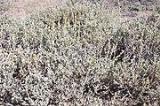
Artemisia arbuscula
Encyclopedia
Artemisia arbuscula is a species of sagebrush
known by the common names little sagebrush, low sagebrush, or black sagebrush.
It is native to the western United States from Washington to California
to Colorado
, where it grows in open, exposed habitat on dry, sterile soils high in rock and clay content. This is a gray-green to gray shrub
forming mounds generally no higher than 30 centimeters. Its many branches are covered in hairy leaves each less than a centimeter long. The inflorescence
is a spike-shaped array of clusters of hairy flower heads
. Each head contains a few pale yellow disc florets. The fruit is a tiny achene
less than a millimeter wide.
Sagebrush (plant)
Sagebrush is the common name for Artemisia tridentata and a number of other species of shrubby plants in the genus Artemisia, native to the North American west and other parts of the world. It is sometimes confused with sage plants ....
known by the common names little sagebrush, low sagebrush, or black sagebrush.
It is native to the western United States from Washington to California
California
California is a state located on the West Coast of the United States. It is by far the most populous U.S. state, and the third-largest by land area...
to Colorado
Colorado
Colorado is a U.S. state that encompasses much of the Rocky Mountains as well as the northeastern portion of the Colorado Plateau and the western edge of the Great Plains...
, where it grows in open, exposed habitat on dry, sterile soils high in rock and clay content. This is a gray-green to gray shrub
Shrub
A shrub or bush is distinguished from a tree by its multiple stems and shorter height, usually under 5–6 m tall. A large number of plants may become either shrubs or trees, depending on the growing conditions they experience...
forming mounds generally no higher than 30 centimeters. Its many branches are covered in hairy leaves each less than a centimeter long. The inflorescence
Inflorescence
An inflorescence is a group or cluster of flowers arranged on a stem that is composed of a main branch or a complicated arrangement of branches. Strictly, it is the part of the shoot of seed plants where flowers are formed and which is accordingly modified...
is a spike-shaped array of clusters of hairy flower heads
Head (botany)
The capitulum is considered the most derived form of inflorescence. Flower heads found outside Asteraceae show lesser degrees of specialization....
. Each head contains a few pale yellow disc florets. The fruit is a tiny achene
Achene
An achene is a type of simple dry fruit produced by many species of flowering plants. Achenes are monocarpellate and indehiscent...
less than a millimeter wide.

